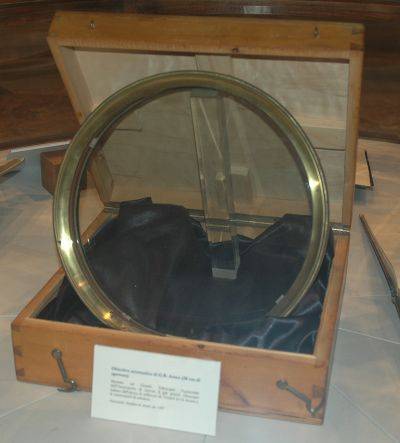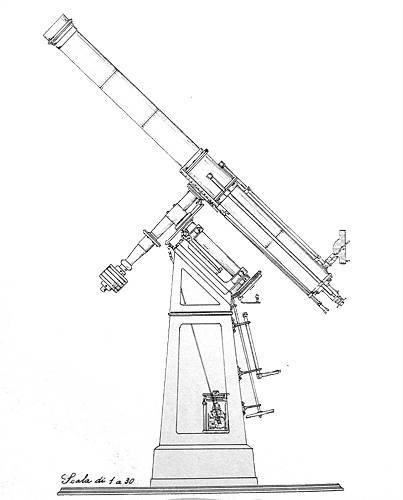The Amici Telescope
In 1831, Giovanni Battista Amici, an optician from Modena, was invited by the Grand Duke Leopold II to preside as the Professor of Astronomy and to direct the "Specola", the observatory in Florence which was attached to the Royal Museum of Physics and Natural History. The new Professor of Astronomy found his institute with very little instrumentation and, therefore, worked to obtain the necessary funding from the governmental authorities, to build an instrument that met the needs of that time.
 At the 3rd Meeting of the Italian Scientists, held in Florence in 1841, Amici presented an objective lens with a diameter of 28 cm and a focal length of 5.3 m. This acromatic doublet, composed of a lens of crown glass and another of flint glass produced by the Guinand factory in Paris, was made in the workshop of the Museo by the mechanic Toussaint, under the supervision of Amici. It was later improved with a crown lens of better quality, and mounted on a mahogany tube (now at Museo Galileo). For about 40 years, the great refractor of Prof. Amici was the largest refracting telecope available in Italy.
At the 3rd Meeting of the Italian Scientists, held in Florence in 1841, Amici presented an objective lens with a diameter of 28 cm and a focal length of 5.3 m. This acromatic doublet, composed of a lens of crown glass and another of flint glass produced by the Guinand factory in Paris, was made in the workshop of the Museo by the mechanic Toussaint, under the supervision of Amici. It was later improved with a crown lens of better quality, and mounted on a mahogany tube (now at Museo Galileo). For about 40 years, the great refractor of Prof. Amici was the largest refracting telecope available in Italy.
The first documented observations with this telescope date back to 1854. From that year, the telescope was used by Amici's young assistant, Giovan Battista Donati, mainly for observing comets and asteroids. The telescope did not have an equatorial mount, and it was used with great effort on the terrace of the Specola. Donati wrote in 1857: "The objective of this telescope […] would be very precious for astronomical observations, if one did not have to fight with the difficulty of moving it conveniently, because of its provisional mounting".
After the repeated insistences of Donati, Director of the "Specola" from the end of 1859, the Italian Parliament in 1864 approved a funding to build a new equatorial mount, a clockwork movement and a dome for the telescope. The mount was built by the mechanic Giuseppe Poggiali in a workshop he found together with Donati, later named Officina Galileo. The dome was made of wood, with a metal frame built by the Pignone foundry. Mount and dome could not be fitted to the old buildings of the Specola; in fact, Donati was already planning a new observatory to be built on the hill of Arcetri, with a new edifice suitable for the telescope.
The dome was erected in Arcetri even before the completion of the Observatory, and the telescope was presented in this provisional installation to a group of foreign and Italian scientists in 1869. In 1872 the telescope was finally installed on the main building of the Observatory. Unfortunately, when Donati died in 1873 the telescope had not been completed yet. The German Wilhelm Tempel, astronomer in Arcetri from 1875, had to use it without clockwork movement and graduated circles. Despite that, Tempel used the telescope successfully, discovering with it about 100 galaxies, which were later included in the New General Catalogue of Dreyer. He also made beatiful drawings of nebulae. Tempel named the telescope Amici I, to distinguish it from another telescope made by Amici and bought for the Observatory in 1875, the Amici II. With Amici I, Tempel also discovered comet C/1877 T1.
 The Amici I telescope was disassembled at the end of 1887, because of imminent renovations of the building of the Observatory. Antonio Abetti, new director of the Observatory, wrote: " in 1894, shortly after my appointment as Director of this Observatory, in taking over the establishment and its belongings, I found the large Amici equatorial dismantled from its pedestal, and recovered, with other instruments, in a place far from the Observatory, where it had been placed by Tempel, to remove it from any damage that could have been brought to it due to the ruinous state of the Observatory then." Abetti had the mount rebuild in the workshop of the Observatory of Padua; a larger metal tube was provided, suitable for an objective of larger aperture than Amici I.
The Amici I telescope was disassembled at the end of 1887, because of imminent renovations of the building of the Observatory. Antonio Abetti, new director of the Observatory, wrote: " in 1894, shortly after my appointment as Director of this Observatory, in taking over the establishment and its belongings, I found the large Amici equatorial dismantled from its pedestal, and recovered, with other instruments, in a place far from the Observatory, where it had been placed by Tempel, to remove it from any damage that could have been brought to it due to the ruinous state of the Observatory then." Abetti had the mount rebuild in the workshop of the Observatory of Padua; a larger metal tube was provided, suitable for an objective of larger aperture than Amici I.
The renovated telescope was intensively used for micrometric measurements of double stars and observations of comets and asteroids. In 1921, Giorgio Abetti, having succeeded his father as Director of the Observatory, began to use the telescope for solar studies, too. The old objective Amici I, was replaced in 1925 by a modern Zeiss objective of 36 cm in diameter and a slightly longer focal length. Despite this substitution, Giorgio Abetti decided to maintain the name "Amici" for the telescope. In 1959, following the building renovation of the Observatory wanted by director Guglielmo Righini, the telescope was moved from its original location in the central dome of the Observatory to the pavilion that houses it today. Nowadays the telescope is used for outreaching activities. The Amici I objective is still held at the observatory.



